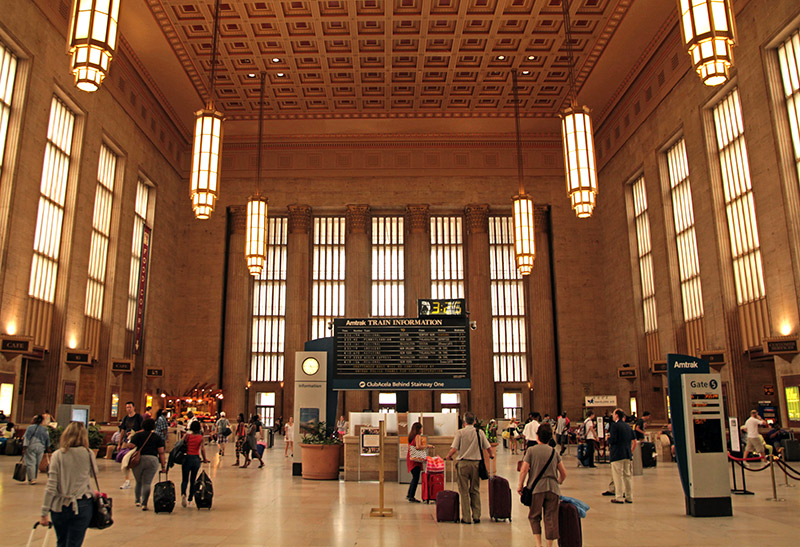
Passenger concourse inside Philadelphia 30th Street Station; (c) Soul Of America
Interstate High Speed Rail Acela Promise
For dinner with my Hound Phi Hound brothers from college, I chose a restaurant in Philadelphia 30th Street Station. Since I booked a ride on Amtrak Northeast Regional to Baltimore that evening, there would be no last-minute rush to the station. To my surprise, an investigative journey of Interstate High-Speed Rail in Amtrak Northeast Corridor would begin — Thomas Dorsey, Soul Of America
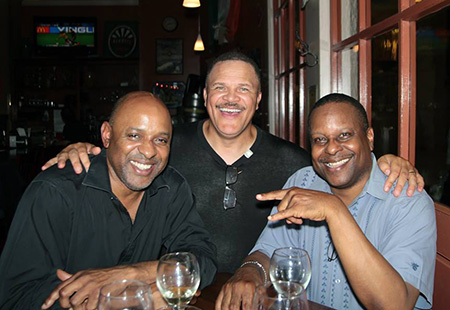
Donny Jones, Thomas Dorsey and Bob Davis at 30th Street Station
After chopping it up with the brothers, I discovered that my Amtrak Northeast Regional train was canceled. The next Amtrak Northeast Regional train would arrive an hour after the next Amtrak Acela train. That meant I would get home so late that Mother wouldn’t be awake when her son from California visited. So late that her mouth-watering, “slap somebody” sweet potato pie would have to chill.
Under Amtrak rules, you can’t take the Acela train having paid for a less expensive Northeast Regional train, as that would be a sneaky upgrade. But since I didn’t cause the long delay before the next Northeast Regional and it was already past 9 pm, I should not have to pay for a ticket upgrade to get the next train to Baltimore.
To my good fortune an Amtrak agent, Ricarda Burrell, jumped through hoops to get me on the next Acela train. I made it home to Baltimore in time for Mother’s welcoming smile and a hot slice of that slap-somebody sweet potato pie.
Nevertheless, my experience illustrates that Amtrak Acela and Amtrak Northeast Regional services fall short of the world-class High-Speed Rail that other nations enjoy. How could that be in the wealthiest country on Earth? That question prodded the travel publisher and transportation analyst in me to discover why it takes so long to fix.
Old Infrastructure Cripples Northeast Corridor Railway
Boston-NYC-Washington corridor (“Northeast Corridor”) contains America’s largest residential, business, government, collegiate, and medical concentration. It produces a quarter of America’s economic activity. It attracts the most tourists. Northeast Corridor features the most Americans riding passenger trains.
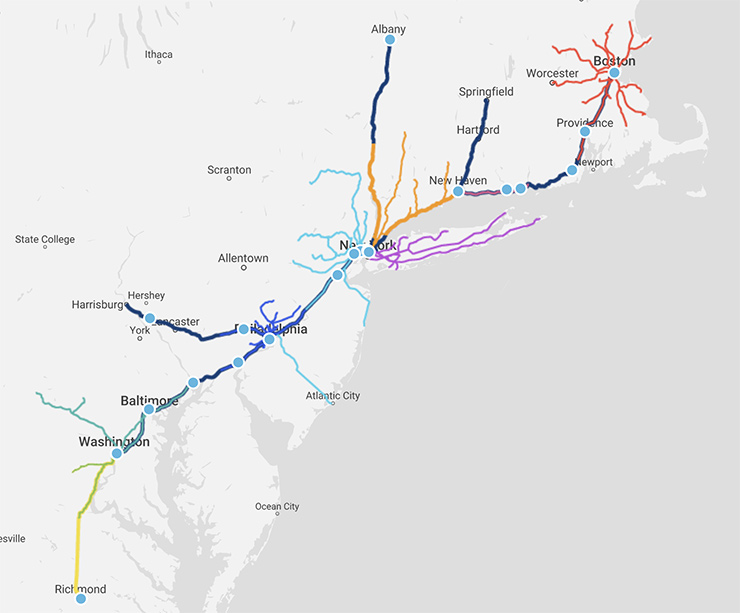
Amtrak owns dark blue track segments; rest is owned by state transit agencies; (c) Amtrak
Today, 363 miles of the 457-mile Northeast Corridor railway are owned by Amtrak. State transit agencies own the rest. Amtrak and state transit agencies have track-sharing agreements with freight rail companies. Each pre-pandemic weekday, 2,000 commuter trains, 140 Amtrak trains, and 60 freight trains use the corridor.
Think of the Northeast Corridor as two major railway segments connecting at New York Penn Station. By handling 600,000 daily pre-pandemic passengers, it is America’s busiest intermodal transportation center for intercity passenger trains, commuter trains, and rapid transit.

As of 2022, the fastest Acela time times was 2 hours 51 minutes for the Washington-NYC segment and 3 hours 36 minutes for the NYC-Boston segment. Amtrak and commuter trains operate best where the corridor has 2 straight tracks for bi-directional Amtrak trains, 2 tracks for bi-directional commuter trains and freight trains, and 1 or 2 intermittent siding tracks for slow freight trains to pull aside.
Northeast Corridor has the oldest railway in America. That legacy includes many old movable bridges that sit low above the water. Given Maritime Law prevails over Railway Law, movable bridges are required to open so tall ships can pass. The manual opening & closing of movable bridges take a crew 15-30 minutes. Hence, the unpredictable passing of a tall ship can wreck a passenger train schedule.
Weather events also introduce delays by triggering unscheduled repair of old bridges, tunnels, track switches, electric power systems, and signaling.
The most frequent cause of schedule delay in the Northeast Corridor is when it constricts from 4 tracks to 3 tracks, then 2 tracks. Since they are shared by Amtrak, commuter trains, and slow freight trains, these chokepoints limit passenger train speeds and frequency.
The worst chokepoint is between New York Penn Station and Newark Penn Station as seen on the map below.
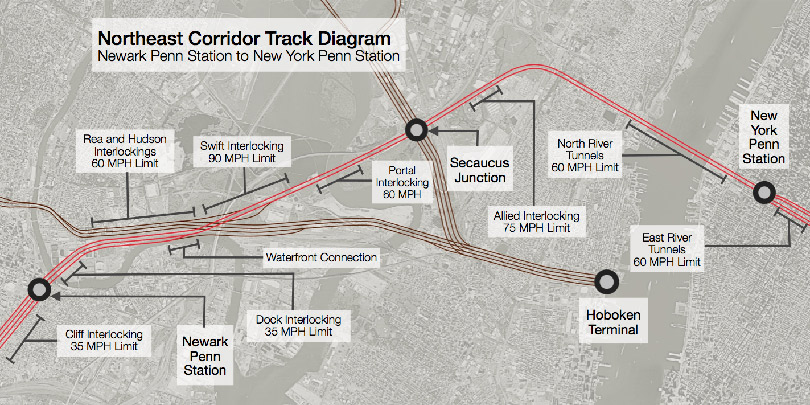
Slow Zones from Newark Penn Station to New York Penn Station; credit realtransit.org
From the east side, East River Tunnels bring 4 tracks into New York Penn Station. From the west side, Hudson River Tunnels (“North River Tunnels”) bring 2 tracks into New York Penn Station. Fewer trains can enter & exit per hour from the west side. When major weather events trigger the unscheduled repair of the Hudson River Tunnels (1908) and East River Tunnels (1910) they become chokepoints.
Old track switches (6 Interlockings on map) and a junction (“Waterfront Connection” on map) handle Amtrak and commuter trains (red tracks). Commuter trains from Hoboken (brown tracks) merge with red tracks heading to Newark Penn Station or points west. All the track switches limit Amtrak and commuter train speeds to 35, 60, 75, 80 & 90 mph over that 12-mile chokepoint. The Portal Interlocking also contains an old movable bridge.
By comparison in France, most TGV trains reach or slow from 99-112 mph (160-180 kph) a few blocks after leaving or entering stations.
The second worst chokepoint is where the American railway began in 1830 — Baltimore. One curvy 3-track tunnel opened in 1873 forces Amtrak, commuter trains, and freight trains to enter & exit the west side of Baltimore Penn Station at 30 mph for about 6 miles.
The third worst chokepoint is the mile-long Susquehanna River Bridge in Maryland. Opened in 1906, the bridge has the triple penalty of being a movable bridge, constricting 4 tracks to 2 tracks, and not designed for speeds above 125 mph. By comparison, TGV runs 180-199 mph across high-speed bridges in France.
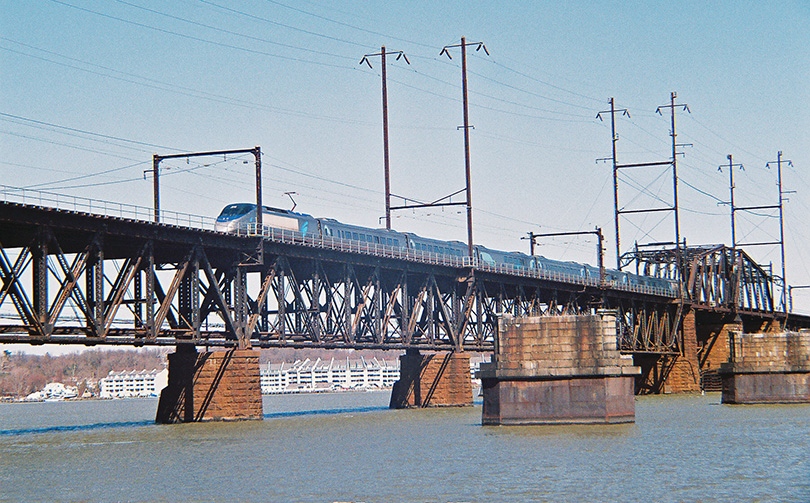
Acela running southbound towards Baltimore on Susquehanna River Bridge built in 1906; credit James G. Howes
Railway infrastructure is worse east and northeast of New York Penn Station. NYC-New Rochelle-Stamford-New Haven-Old Saybrook-New London-Providence segment had more old movable bridges, old track switches, old signaling, old power systems & overhead wires. Tracks constrict from 4 to 3 to 2 tracks too often. Amtrak crosses commuter rail in more junctions. A dozen railroad crossings for automobiles limited Amtrak speeds below 80 mph and a devil’s abundance of sharp curves limited speeds to 30-60 mph.
Those chokepoints produced a lousy and bumpy 4-hour 30-minute NYC-Boston trip time. Eliminating those chokepoints would save 10-12 minutes.
Blown Opportunities
America’s federal and state leaders have had many chances to build a world-class High-Speed Rail corridor when property and labor were cheap.
In 1965, Congress and President Johnson introduced the first HSR project between Washington, Baltimore, Philadelphia, Newark, and NYC. If we got serious about HSR, America would have an Interstate HSR System 6 times larger than the one in France. We could have saved over a million railroading jobs.
To America’s detriment, every combination of Congress and President since 1965, failed to scale up railway infrastructure investment. Even if we excuse them from being distracted by the Vietnam War, they should have ramped up HSR investment in 1974 when the war effectively ended.
Many passenger rail advocates thought Congress and President Clinton would finally get serious about HSR in 1993. America was emerging from economic recession and was the richest nation on Earth. The 1990 Gulf War ended quickly, so we could allocate more taxes on Transportation Infrastructure.
Northeast Corridor, the densest in America, had grown to 45 million residents. That was nearly 4 times more people than France had when it started building its first HSR corridor. More Americans flying caused longer airport queues for ticketing, luggage handling, security screening, and boarding & unboarding. Increasing flights between Boston, NYC, Newark, Philadelphia, Baltimore, and Washington made airport queues worse than in other regions. When you include taxi rides to & from the airport from Central Washington to NYC (Manhattan), Total Air Travel Time ballooned to 3 hours 30-45 minutes depending on endpoints. Today, it’s 3 hours 45 minutes to 4 hours depending on endpoints.
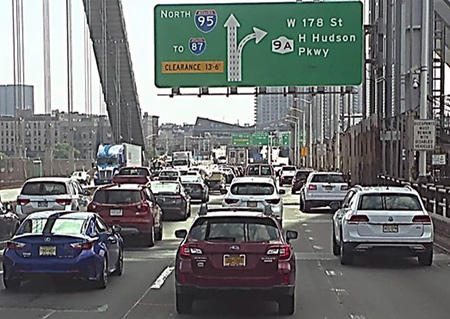
I-95 Freeway traffic entering NYC via George Washington Bridge
Driving the corridor also got more expensive and slower. More toll stations brought in revenue to maintain I-295 Tollway, but increased I-95 Freeway congestion and slowed average driving speed below 60 mph.
Assessing those conditions in America’s most important economic region, President Clinton’s U.S. Department of Transportation (USDOT) and state DOTs wanted an alternative to highways and airports. They wanted TGV-style HSR in the Northeast Corridor. The trouble was, no one wanted to pay the infrastructure cost to produce it.
Long story short, Congress & President Clinton, and Northeast state legislatures & governors needed to invest $20 billion in the 226-mile NYC-Washington corridor segment.
That was a reasonable sum considering America’s GDP size and that the Northeast Corridor was responsible for about 20% of GDP. Acela trains were capable of 165 mph in commercial operation. On better infrastructure, they could produce a 2-hour 15-minute NYC-Newark-Philadelphia-Baltimore-Washington trip time.
News media would have sung their praises and demanded more investment in the NYC-Boston corridor segment for a 2-hour 45-minute NYC-Boston trip time. Despite that low-risk infrastructure opportunity, our leaders invested only $4.3 billion spread thinly across the 457-mile Northeast Corridor.
Despite Shortcomings, Northeast Corridor HSR Operates at a Profit
Amtrak Acela service began in December 2000. Once the 9-11-2001 Terrorist Event occurred, security check hassle and queues amplified at all of America’s large and medium airports. Though flight time remained 50 minutes between Washington and NYC, Total Air Travel Time ballooned to 4 hours on average.
In contrast, Northeast Corridor HSR travelers could buy tickets online and arrive 10-15 minutes before their scheduled train and breeze through security. Station platforms are level with train floors. Passenger trains have 2 doors per cabin. Riders could swiftly board. Once train riders arrived in a Central Business District, they could walk, take a taxi, ride Metro Rail, or ride Commuter Rail to final destinations.
In 2022, the fastest Acela NYC-Washington trip time was 2 hours 51 minutes. The fastest Acela NYC-Boston ride time was 3 Hours 35 minutes. Total Acela Travel Time would include Walking/Taxi/Uber/Lyft to/from train stations would vary depending on the origin and destination, but on average, would be less than Total Air Travel Time to central cities.
Northeast Corridor HSR delivered more advantages than flying in the corridor. Acela’s 88-90% reliability beat airlines’ 73-80% reliability. Travelers value visiting the Cafe Car and restroom at their leisure. Amtrak Northeast Regional offered fares competitive with most Coach Class airfares in the corridor. All flights between Washington and Boston have only 10-18 minutes of cruising altitude when you can open a laptop for work or entertainment.
In contrast, all trip time on Amtrak is available for work or entertainment between these city pairs; their trip times range from 22 minutes to 4 hours:
• NYC-Philadelphia
• NYC-Baltimore
• NYC-Washington
• Philadelphia-Baltimore
• Boston-New Haven
• Boston-NYC
• NYC-Providence
• Newark-New Haven
• Newark-Providence
• Newark-Boston
• Philadelphia-New Haven
• Baltimore-New Haven
• Baltimore-Washington
Despite lackluster performance by HSR standards, Amtrak Northeast Corridor HSR services have been profitable since 2006.
Obama’s Unfulfilled High-Speed Rail Promise
President Obama made a campaign promise for huge federal investment in HSR projects sponsored by Amtrak or state governments. There were a number of ready-to-build and near-ready HSR projects in the Northeast Corridor, California, Florida, Milwaukee-Chicago-Detroit, and Chicago-St. Louis corridor. To build HSR correctly, those projects needed $65 billion from the $787 billion Economic Stimulus authorized in 2009.
Northeast Corridor HSR needed $20 billion in USDOT grants. California HSR needed $20 billion, Florida HSR needed $10 billion, Milwaukee-Chicago-Gary-Kalamazoo-Detroit HSR needed $9 billion and Chicago-St. Louis HSR needed $6 billion. State, county & freight rail company matching funds would range between 30-35% of project costs. Amtrak Regional & Long-Distance trains also needed a $10 billion grant to address their maintenance backlog.
Focusing on other campaign priorities, President Obama gambled that he could short-fund Amtrak-HSR projects his first two years, and then make up for it in his next two years. Obama approved only $8.5 billion in economic stimulus funds for all HSR projects and $5 billion to address the Amtrak maintenance backlog. Given the political nature of infrastructure funding, the Federal Railroad Administration and Amtrak had to spread that $13.5 billion thinly across too many projects in too many states.
When the Surface Transportation Bill came up for renewal in 2011, President Obama hoped that Congress would approve his $55 billion/6-year Amtrak-HSR proposal to help quicken economic recovery from the Great Recession. The November 2010 Election shattered his hope.
In 2011, the new Congress halted additional funding for Amtrak-HSR projects. Consequently, HSR achievements during the Obama Administration were limited to:
• Modernization of 23 HSR miles in New Jersey
• Partial modernization of 30 HSR miles between Washington and Baltimore
• Funding the equivalent of 40 HSR miles in California’s Central Valley
Just before leaving office, President Obama convinced Congress to loan Amtrak $2.5 billion to purchase Nextgen High-Speed Trains. They are being built in America by Alstom, the French company renowned for building TGV trains.
By February 2020, Amtrak was transporting more travelers in the corridor than airlines finally leading Amtrak to profitability. Though the pandemic butchered ridership and slowed project construction for 20 months, there was some countervailing good news.
In 2021, the long-awaited New York Penn Station-Moynahan Hall opened with architectural features and amenities comparable to Grand Central Terminal. In 2025, New York Penn Station anticipates 700,000 daily patrons — more than most Hub Airports in America.
Infrastructure Bill Anchors Northeast Corridor Phase 1 Modernization
The 2021 Bipartisan Infrastructure Law (BIL) will combine new federal funds with the standard Amtrak budget awarded through USDOT as grants. Affected states, counties, and freight rail companies will co-fund Amtrak Northeast Corridor projects. Privately-owned Transit-Oriented Developers also co-fund station-related retail, hotel, residential & office projects. In 2023, Amtrak Northeast Corridor projects received the first $16.4 billion of $30 billion in committed USDOT grants.
Nextgen Acela trains (“Avelia Liberty”) will replace current Acela trains. They accelerate & brake faster and tilt up to 10 mph faster in curves.
Amtrak promised 165 mph top speed in the Northeast Corridor two decades ago. Europe and Japan are upgrading several 155 mph HSR routes to 168-174 mph. Avelia Liberty trains are designed for tilting through mild curves at 185 mph. Given those facts, I’m underwhelmed by Amtrak Acela’s 160 mph speed upgrade in Phase 1. But I know that it still increases Acela’s time savings, frequency, and schedule reliability.
Passengers will appreciate better seats, lighting, and WiFi. Old Acela 5-cabin trains offer only First & Business Class fares. Nextgen Acela 8-cabin trains will offer First, Business & Coach Class fares. The Cafe Car is better stocked. Nextgen Acela adds 8 more trains to daily service. Train frequency improves from a 30-minute Peak & 50-minute Off-Peak to a 15-minute Peak & 30-minute Off-Peak.
Combining USDOT, state, county & freight rail company funds Amtrak will likely receive $46 billion total for Northeast Corridor Modernization Phase 1 projects to be complete by 2035.
Major upgrades are also coming to Washington Union Station, Philadelphia 30th Street Station, Boston South Station, Baltimore Penn Station, Newark Station, New Haven Station, and Stamford Station in the corridor.
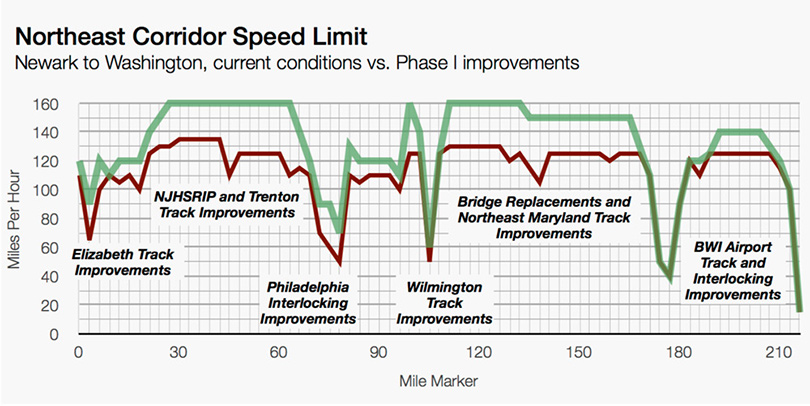
Acela NYC to Washington Speed Limit Current & Infrastructure Modernization Phase 1; credit RealTransit.org
By 2030, a Washington-Baltimore-Philadelphia-Newark-NYC Limited Stop trip time should shrink to 2 hours 36 minutes.
By 2035, the new Hudson River Tunnel and refurbished Hudson River Tunnels should be completed. Chokepoints in the curvy Newark-NYC-Stamford-New Haven segment will be eliminated to sustain 90-100-110 mph speeds. More upgrades will enable Acela to sustain 160 mph over 132 miles.
In 2035, Amtrak targets 2 hours 25 minute Acela Washington-Baltimore-Philadelphia-Newark-NYC Limited Stop trip time and 3 hours 8 minute Acela Boston-Providence-New Haven-Stamford-NYC Limited Stop trip time. Though Amtrak hasn’t promised an estimated Northeast Corridor schedule reliability number for 2035 yet, it should rise to 94-95%.
Northeast Corridor Phase 2 Modernization Needs Funding
Business travelers would gladly pay premiums for a sub-2-hour Washington-Philadelphia-NYC trip time enabling more day trips before returning home for dinner. They would also pay a premium for a 4-hour Washington-Philadelphia-NYC-Boston trip time featuring 96-97% schedule reliability unavailable to Air Travel. Those keys are driving Phase 2 upgrade plans.
New Haven-Boston segment already has a 25-kilovolt electric system necessary for high speeds. In Phase 2, all of the Washington-NYC-Boston Corridor will have a 25-kilovolt electric system. A second Portal Bridge in Newark-NYC segment is planned. More curve straightening and signal upgrades are coming to New Jersey and Pennsylvania to achieve 185 mph. A dedicated 200-220 mph bypass tracks is planned within the Delaware-Eastern Maryland segment.
Shortly after 2040, the combination of 185-200-220 mph Acela speeds without chokepoints should achieve these performance metrics:
226-Mile NYC-Philadelphia-Washington Segment
• 1-hour 45-minute Express trip time
• 72 daily Amtrak roundtrips
• 96% schedule reliability
Improving infrastructure from New Haven through southeastern Connecticut is the larger challenge of Phase 2.
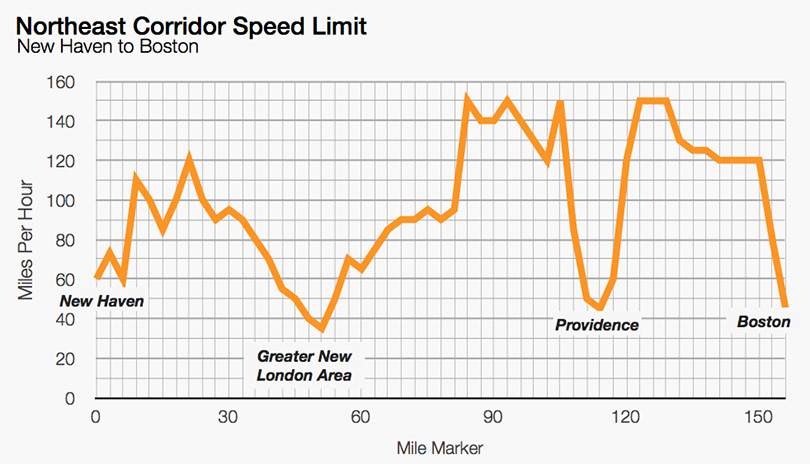
Acela Speed Limits from New Haven to Boston; credit RealTransit.org
For Avelia Liberty to reach 185 mph in New Haven-Old Saybrook segment, the upgrade requires mild curve straitening, expansion to 2 bi-directional tracks for Amtrak and 2 bi-directional tracks for commuter rail and freight rail. There is little opposition to that happening by 2040.
Fixing the 57-mile Old Saybrook-New London-Kingston segment is the heaviest lift. Though a 185 mph upgrade to the Rhode Island-Connecticut border is straightforward, 10 coastal railroad crossings in southeastern Connecticut limit Amtrak to 35-80 mph speeds.
Northeast Corridor Phase 1 will add 3 railroad overpasses that boost speed a little and increase schedule reliability. The takeaway, however, is that coastal track has so much surrounding development that it’s impractical to straighten curves and build the last 7 railroad overpasses in southeastern Connecticut.
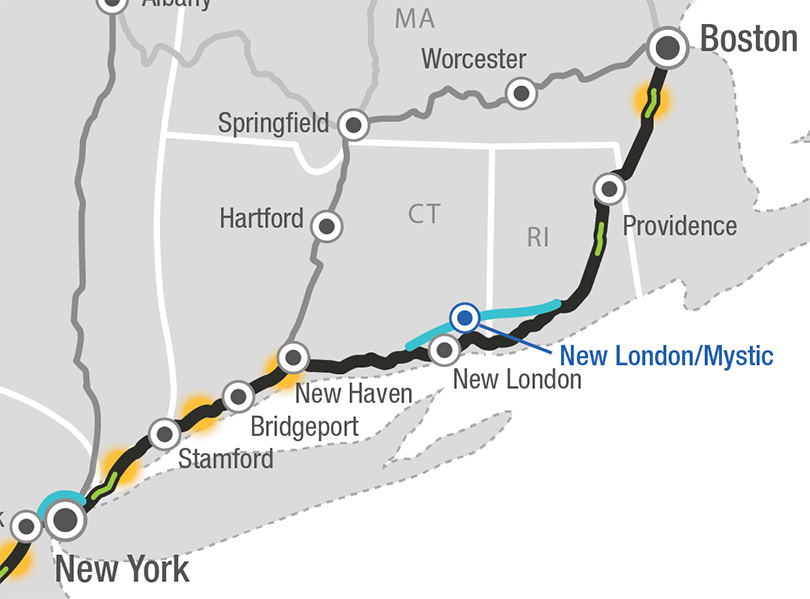
Amtrak NEC Bypass Alternative 1, orange highlights Slow Zones; credit CTMirror.org
The best Amtrak Alternative I’ve seen is an Old Saybrook-New London-Kingston segment proposal to reach 220 mph via a $66 billion Amtrak NEC Bypass Alternative 1. It would skip 50 miles of coastal curves. It’s the light blue line on CTMirror’s Boston-Providence-New London-New Haven-Stamford-NYC Railway Map.
Global Warming is causing sea level rise and higher storm surges, like those by Superstorm Sandy. A respected Bloomberg BusinessWeek report indicates that Global Warming is accelerating with devastating consequences to coastal property, railways, and roadways. An inland bypass can protect Amtrak Northeast Corridor against sea-level rise, yet still, be close to coastal Connecticut’s New London and Mystic cities.
Amtrak prefers NEC Bypass Alternative 1 because it represents tremendous trip time savings and less expense, yet continues service to southeastern Connecticut. Exiting Old Saybrook, it would run parallel to I-95 Highway to an inland New London/Mystic Station, then go to Rhode Island. Only a short drive to the New London/Mystic Station is required.
Most protestors want to maintain the current Amtrak coastal service. They’ve enlisted support from the Connecticut governor, congressmen, and coastal mayors to prevent an in-land HSR bypass.
Amtrak NEC Bypass Alternative 2 would skip from Kingston to Hartford, yielding a 1-hour 34-minute Boston-NYC Express trip time. Since it would eliminate Acela service in southeastern Connecticut, that’s not popular with protestors either.
Even if leading nations slow greenhouse gas emissions, the sea level will rise 2 feet by 2050. That rise will have bad economic, transportation, ecological, and weather consequences.
In 2012, Superstorm Sandy proved that coastal threat with 10 10-foot storm surge in lower Manhattan. As the nation’s financial hub and population-densest location, NYC will attract the largest share of federal funds towards $100 billion in seawall and infrastructure hardening to protect against sea level rise and storm surge.
Many other large coastal American cities will receive billions in federal funds for seawall and infrastructure hardening too.
As the Hurricane Irene video proved, southeastern Connecticut is subject to storm surges. As storm surge heights increase, it will be impossible to get flood insurance on coastal property. Competing for federal funds against the large coastal cities of America, the small towns of southeastern Connecticut stand less chance of obtaining enough money for a lengthy seawall.
The harsh reality of approaching 2 feet of sea-level rise and storm surges will cause more residents to relocate inland over the next 20 years. Hopefully, it becomes politically easier for Connecticut leaders to request funding for Bypass Alternative 1 by 2028, as it will likely take 12 years of preliminary planning, to collect public input for environmental clearance, rights-of-way acquisition, engineering, and construction.
If Bypass Alternative 1 is selected and funded by 2028, Acela can meet these performance metrics and harden against sea level rise by 2040:
231-Mile Boston-NYC Segment
• 2-hour 15-minute Express trip time
• 54 daily Amtrak roundtrips
• 95% schedule dependability
If Phase 2 is completed in the manner I suggest, add a 5-minute layover in NYC to estimate a 4-hour 5-minute Washington-Philadelphia-NYC-Boston Express trip time with 96% schedule reliability. If First Class includes a fine meal and a fine meal is optional for Business Class, it could take 80% of business travel in the Washington-Philadelphia-NYC-Boston corridor.
Vastly more Boston-Providence-Mystic/New London-New Haven-NYC-Newark-Philadelphia-Wilmington-Baltimore-Washington Limited-Stop trains would also run with a 4-hour 35-minute trip time. In all, Amtrak train frequencies will rise to 54 daily Washington-Boston roundtrips and 72 daily Washington-NYC roundtrips.
NYC Metro Area has an infrastructure investment plan to connect Metro-North Railroad, Long Island Railroad, and New Jersey Transit commuter rail systems at New York Penn Station to enable same-seat rides on each other’s tracks.
The New York MTA plan will upgrade Commuter Rail into Suburban Rail status like the Réseau Express Régional (RER) service in the Paris Metro Area. Many travelers take high-speed trains to Paris, then switch to RER and vice-versa.
When NYC Metro Area Regional Rail Network is fully implemented it will deliver similar benefits. Boston, Philadelphia, Baltimore, and Washington have similar Regional Rail upgrade plans. Better HSR, Regional Rail, Commuter Rail & Metro Rail will be a difference-maker for college students. Maybe your kids will chop it up with college friends at Boston South Station, New York Penn Station, Philadelphia 30th Street Station, Baltimore Penn Station, or Washington Union Station too.
For more insight on how Amtrak Northeast Corridor HSR fits within the big-picture Interstate High-Speed Rail System, click below.

